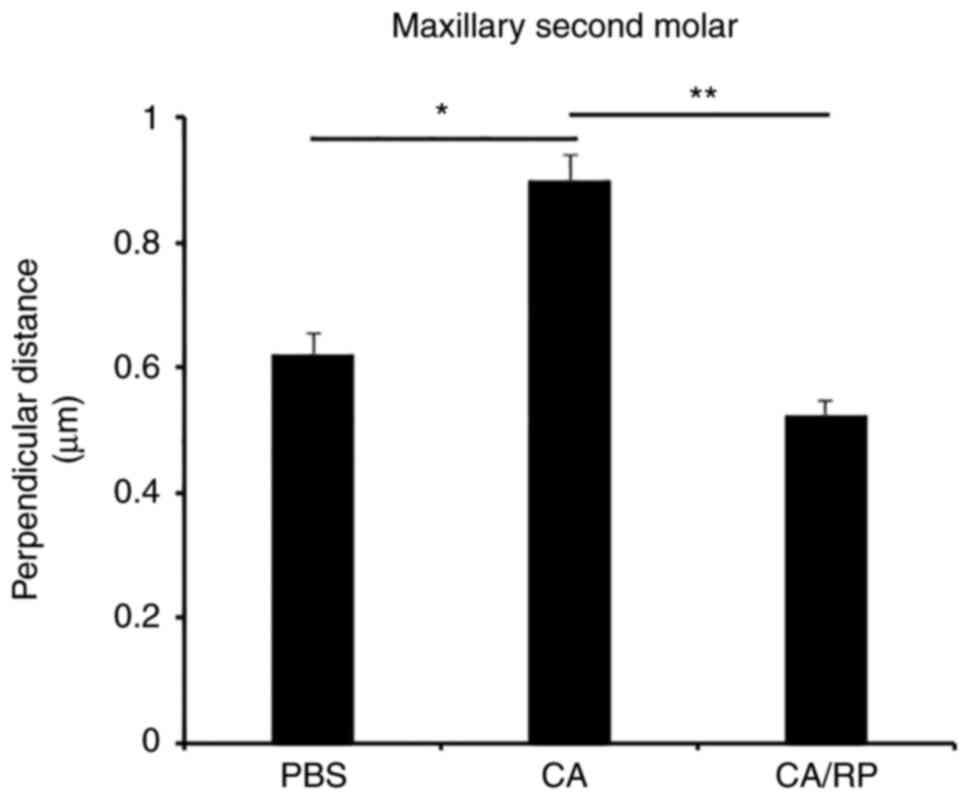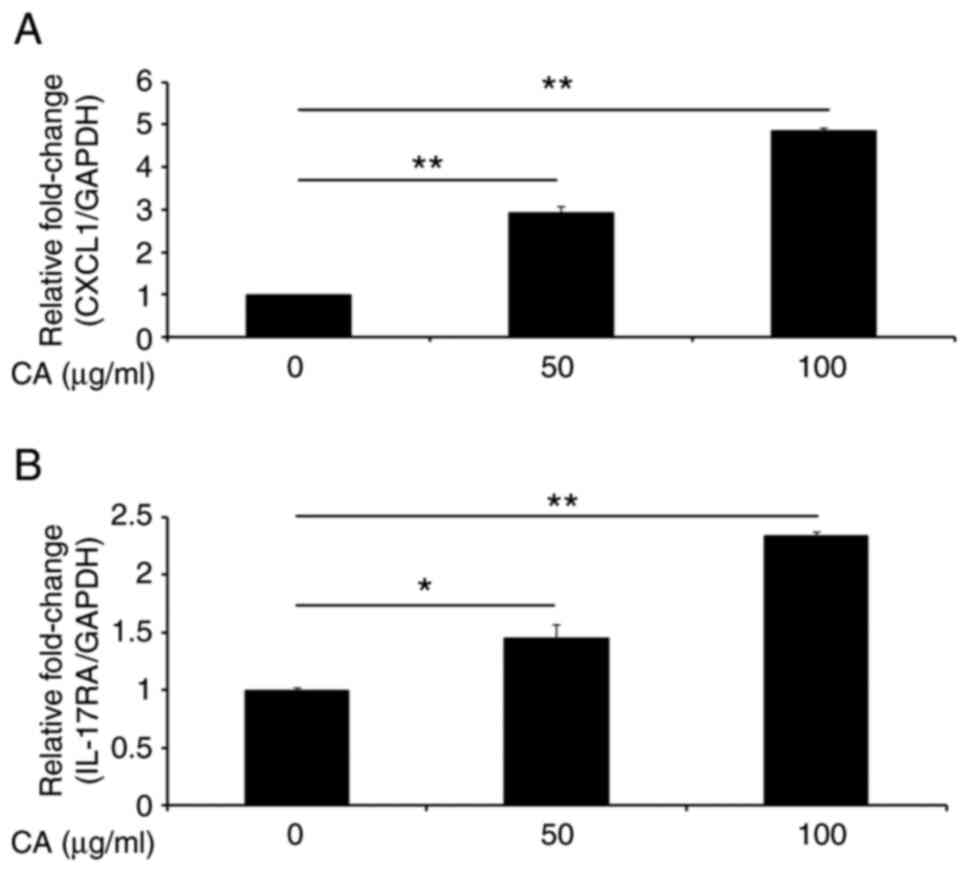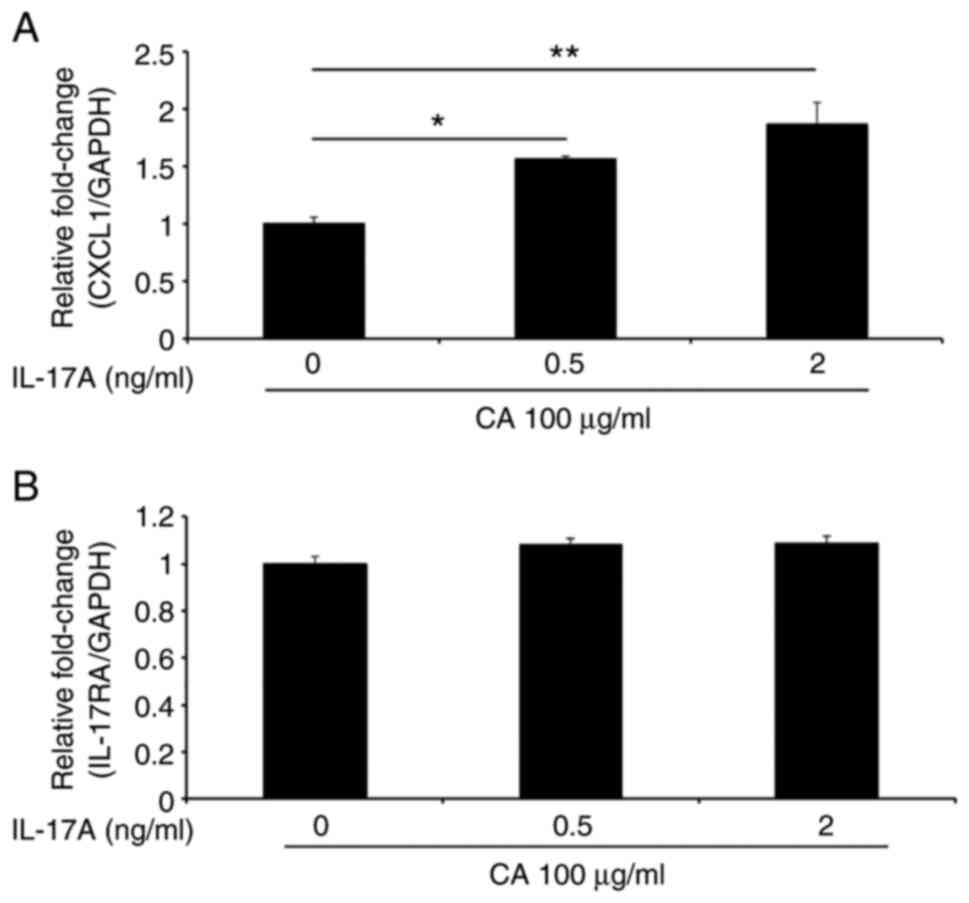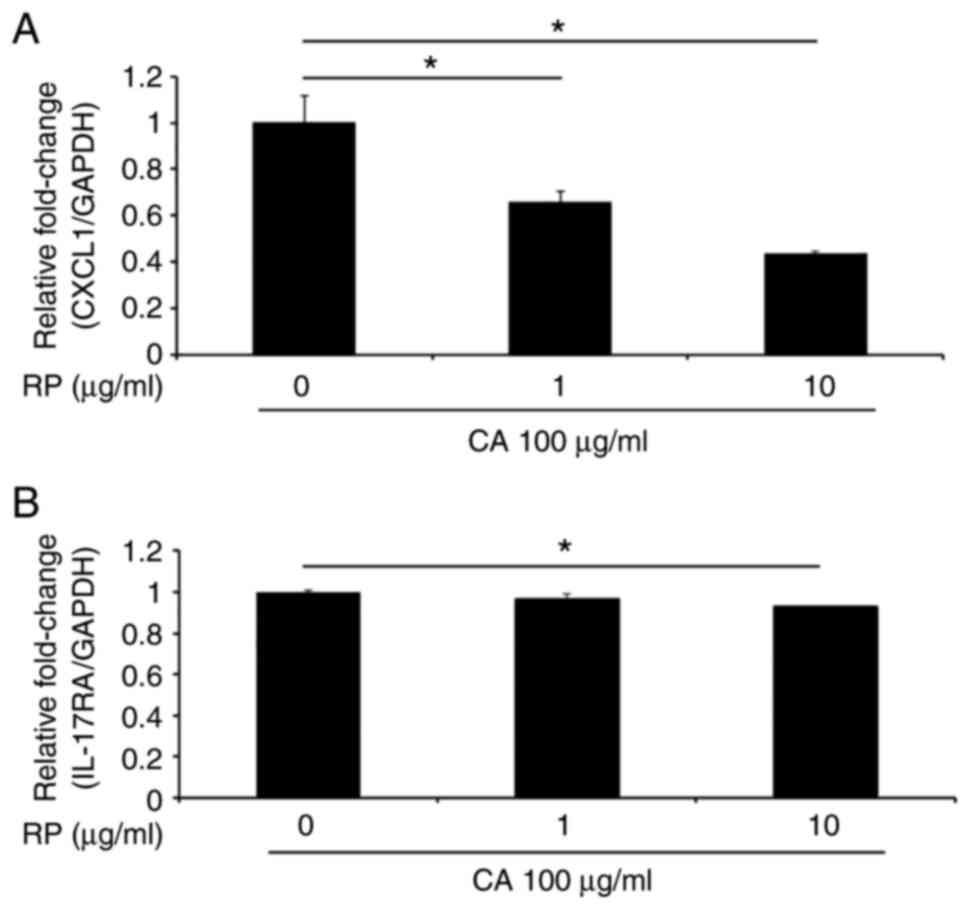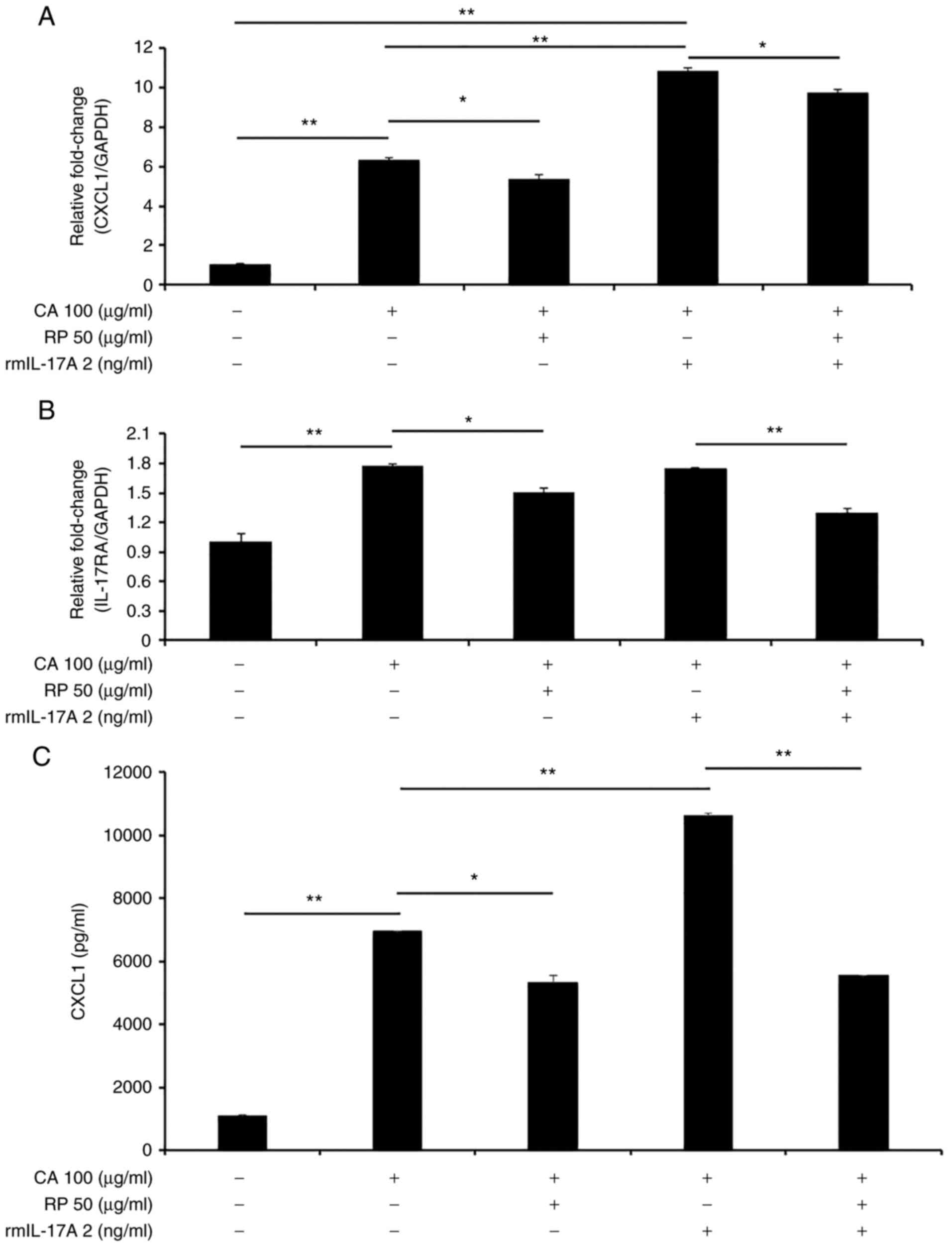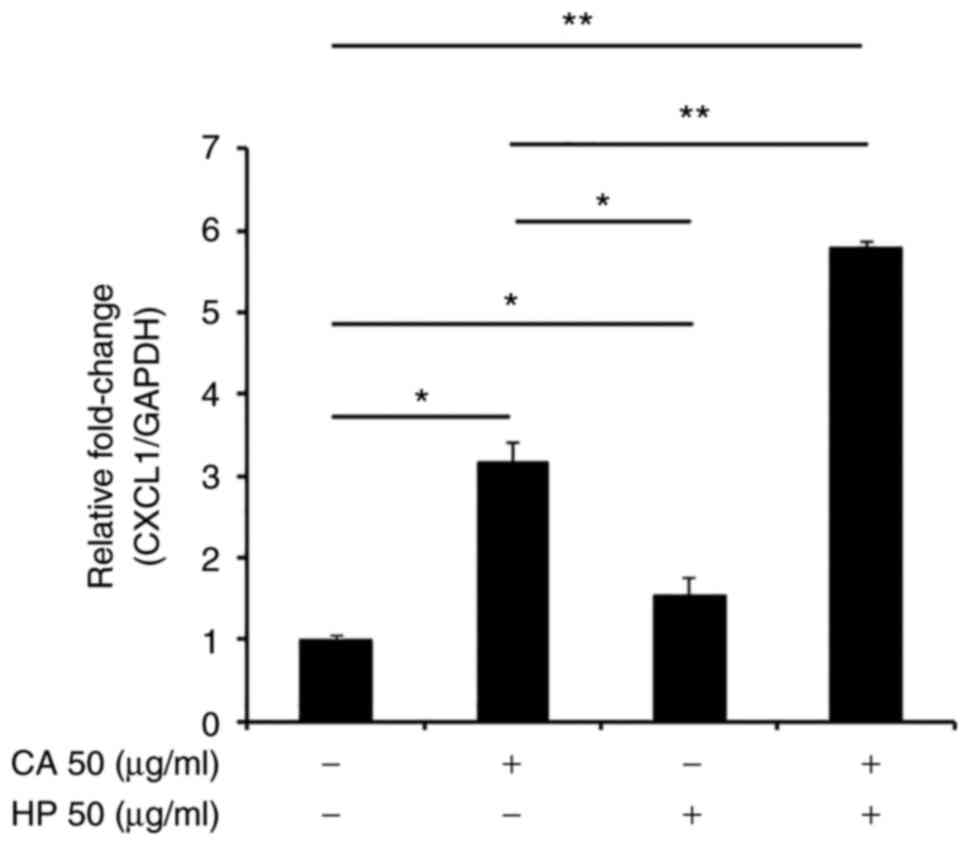Ropinirole inhibits inflammatory cytokine production in gingival epithelial cells and suppresses alveolar bone loss in an experimental rat model of periodontitis
- Authors:
- Published online on: December 29, 2022 https://doi.org/10.3892/etm.2022.11777
- Article Number: 78
Abstract
Introduction
Periodontitis is a chronic inflammatory disease characterized by the loss of periodontal attachment and alveolar bone due to bacterial infection. Neutrophils are the key immune cells involved in periodontitis (1). Gingival epithelial cells produce chemokines, such as interleukin (IL)-8 to recruit neutrophils, and periodontal pathogens stimulate dendritic cells via Toll-like receptors, resulting in the induction of the Th1/Th17 subset. Th17 cells are critical mediators of alveolar bone destruction in periodontitis, and gingival epithelial cells possess IL-17 receptor (IL-17R), to which IL-17 binds to induce IL-8 production (2-4). Although rodents lack a direct homologue of IL-8, the C-X-C motif chemokine ligand 1 (CXCL1) is regarded as a functional homologue of IL-8(5).
The main approach of current periodontal therapy is the physical excision of lesions (6). Scaling and root planing are treatments for removing plaque and calculus from the tooth surface, while periodontal surgery is debridement for excising infected granulation tissue. For deep intrabone defects, it is beneficial to use materials, such as membranes for guided tissue regeneration, enamel matrix derivatives, and fibroblast growth factor-2 (7,8). Additionally, pharmacological therapies are used as adjunctive treatments (7). Chlorhexidine and sustained-release minocycline are locally applied treatments (9,10). For systemic treatments, antibiotics are often used for short periods of time. However, few reports are available on the development of pharmacological treatments for mitigating inflammation.
We have previously demonstrated that dopamine signaling plays a crucial role in Th17 cell differentiation (11,12). There are five subtypes of dopamine receptors, D1 to D5, and these subtypes are classified into two groups: D1-like receptors and D2-like receptors. D1-like receptors, i.e., D1 and D5, induce an increase in intracellular cyclic adenosine monophosphate (cAMP), whereas D2-like receptors, i.e., D2, D3, and D4, induce a decrease in intracellular cAMP (13). In our previous studies, D1-like receptor antagonists inhibited Th17 differentiation, and attenuated neutrophilic inflammation caused by diseases in animal models, such as experimental autoimmune encephalomyelitis, autoimmune diabetes, and nephrotoxic serum nephritis models (11,14,15). It has been reported that Th17 cells markedly produced IL-8, and that the IL-8 production from activated T cells was suppressed by D2-like receptor agonists (16,17), indicating that D2-like receptor agonists can suppress neutrophilic inflammation that has already developed. Moreover, Parrado et al demonstrated that dopamine and D2-like receptor agonists upregulated the expression of IL-8 in keratinocytes (18). Dopamine signaling promotes IL-8 production by stimulating both Th17 cells and epithelial cells via the dopamine receptor.
We also showed previously that tannic acid is a D2-like receptor agonist, and that tannic acid suppressed IL-17 production in chemically induced colitis models (19). More recently, we determined that tannic acid inhibited alveolar bone resorption in a carrageenan-induced rat model of periodontitis (20). In the present study, we examined the effect of the D2-like receptor agonist ropinirole, which is used as a drug for treating Parkinson's disease, on periodontitis in vivo. To also analyze the action in vitro, we evaluated whether ropinirole inhibits cytokine production in a murine gingival epithelial cell line.
Materials and methods
Reagents
We used l-carrageenan (carrageenan; WAKO Pure Chemical Industries Ltd., Osaka, Japan), ropinirole (Sigma-Aldrich Japan, Tokyo, Japan) as a D2-like receptor agonist, haloperidol (WAKO Pure Chemical Industries Ltd.) as D2-like receptor antagonist, and carrier-free recombinant mouse IL-17A (rmIL-17A; R&D Systems, Guthrie, MN, USA). In the preliminary in vitro experiments, we have found that 10 mg/ml is more effective than 1 mg/ml (data not shown). It is enough to conduct the in vivo experiment at one dose (20). According to a paper by Hashimoto et al (15), the endogenous IL-17A concentration is approximately 1.0 to 1.5 ng/ml, and we used this concentration as a reference for deciding on the dose of IL-17A to use in this experiment. We decided on the ropinirole concentrations by referring to previous reports (17,21).
Cell culture
Cells of the murine gingival epithelial cell line GE1 (RCB1709; RIKEN BioResource Center Cell Bank, Japan) were cultured in SFM101 medium (Nissui, Tokyo, Japan) supplemented with 1% fetal bovine serum (Sigma-Aldrich Japan), 100 U/ml penicillin G (Sigma-Aldrich Japan), 100 µg/ml streptomycin (Sigma-Aldrich Japan), and 10 ng/ml epithelial growth factor (Sigma-Aldrich Japan) (22). The cells were incubated in a humidified atmosphere of 5% CO2 at 33̊C. For the in vitro assay, we seeded GE1 cells into 24-well plates at 30x104 cells per well. We added carrageenan at the concentration of 50 or 100 µg/ml and/or rmIL-17A at the concentration of 0.5 or 2 ng/ml to the wells. Ropinirole was added to the wells at the concentration of 1, 10, or 50 µg/ml prior to the addition of carrageenan and/or rmIL-17A. After 24 h of incubation, the cells and supernatants were harvested.
Quantitative reverse transcription-polymerase chain reaction (RT-PCR) analysis
The harvested cells were rinsed with ice-cold phosphate-buffered saline (PBS). QIAzol Lysis Reagent (QIAGEN, Hilden, Germany) was added to the samples, and the total RNA was extracted. The reverse-transcription reaction was performed with a High Capacity cDNA Reverse Transcription kit (Thermo Scientific). TaqMan Gene Expression Assays for CXCL1 (assay identification number: Mm04207460_m1), IL17-RA (assay identification number: Mm00434214_m1), and glyceraldehyde-3-phosphate dehydrogenase (assay identification number: Mm99999915_g1), which was used as an endogenous control, were obtained from Thermo Scientific. As Taqman probes do not provide the sequence information, we cannot show the sequence information. All experiments were performed in quadruplicate, i.e., each reaction was performed in quadruplicate on four individual samples. Values were normalized to those of glyceraldehyde-3-phosphate dehydrogenase using the 2-ΔΔCt method. This experiment was repeated at least three times.
Measurement of CXCL1 in the culture supernatants
CXCL1 protein in the harvested supernatants was measured using a mouse CXCL1 ELISA kit (Proteintech, Rosemont, IL USA) according to the manufacturer's instructions. All experiments were performed in quadruplicate, i.e., each reaction was performed in quadruplicate on four individual samples. This experiment was repeated at least three times.
Carrageenan-induced rat model of periodontitis
The bilateral maxillary bone including the second molar of two rats were used in each group. We used 6 rats in total. The experiments were approved by the Animal Research Committee of Saitama Medical University (approval number: 2877), and conducted according to the institutional guidelines for ethical animal experiments. The humane endpoint is 20% body-weight reduction and severe suffering. All rats were housed in appropriate animal care facilities at Saitama Medical University, Japan. Five-week-old male Wistar rats (200 to 300 g in weight) were obtained from Japan SLC (Shizuoka, Japan). The rats had access to food and water ad libitum, and were maintained on a 12-h light/dark cycle at 23±1˚C with 60±10% humidity. We used a mixture of medetomidine hydrochloride (0.15 mg/kg; Nippon Zenyaku Kogyo, Fukushima, Japan), midazolam (2 mg/kg; Astellas Pharma, Tokyo, Japan), and butorphanol tartrate (2.5 mg/kg; Meiji Seika Pharma, Tokyo, Japan) as an anesthetic mixture, which was administered intraperitoneally (23-25). These drugs do not affect dopamine signaling (26). For euthanasia, sodium pentobarbital (200 mg/kg; Kyoritsu Seiyaku, Tokyo, Japan) was administered intraperitoneally. We verified cardiac and respiratory arrest. We used a previously reported carrageenan-induced rat model of periodontitis (27). While the rats were under anesthesia, buccal and lingual gingiva were exfoliated using an explorer. We divided the rats into three groups: a PBS group, a carrageenan (CA) group, and a carrageenan and ropinirole (CA/RP) group. For the PBS group, silk ligature, cut to the length of the mesiodistal distance of the mandibular second molar, was immersed in PBS, which is the solvent for carrageenan. For the CA group, the silk ligature was immersed in 1% carrageenan. For the CA/RP group, the silk ligature was immersed in 1% carrageenan and 10 µg/ml ropinirole. These ligatures were inserted into the periodontal pocket once a week for 4 consecutive weeks. The ligatures were inserted once a week and removed until the animal was sacrificed. The ligatures did not affect the animals' quality of life because 20% body-weight reduction has not been observed. The experimental protocol is shown in Fig. S1.
Micro-computed tomography (CT) analysis
The rats were euthanized 4 weeks after the first operation. The maxillary bone was dissected, and subsequently fixed with 70% ethanol for analysis on a micro-CT 35 (SCANCO Medical, Brüttisellen, Switzerland). After preparing three-dimensional images (Fig. S2), the perpendicular distance between the cemento-enamel junction and the alveolar margin on the palatal side of the maxillary second molar was measured as shown in Fig. S3(26). This experiment was repeated at least three times.
Statistical analysis
Differences between more than three groups were analyzed by one-way analysis of variance with Tukey's post-hoc tests. P-values <0.05 were considered to indicate statistical significance. All data are presented as the mean ± standard error of the mean. The analyses were performed using EZR software version 1.52 which is a graphical user interface for R (The R Foundation for Statistical Computing, Vienna, Austria) (28). These experiments were repeated at least three times.
Results
Ropinirole suppresses alveolar bone loss in an experimental rat model of periodontitis
Previously, we demonstrated that tannic acid, which is a D2-like receptor agonist, inhibited alveolar bone resorption in a carrageenan-induced rat model of periodontitis (20). In the present study, we used the same model to analyze the function of ropinirole, and conducted micro-CT analysis. The results revealed that the perpendicular distance was increased in the CA group when compared to the PBS group, and the perpendicular distance of the CA/RP group was significantly shorter than that of the CA group (Fig. 1).
Carrageenan induces CXCL1 expression in gingival epithelial cells in association with IL-17 modulation
As an inflammatory cytokine, IL-8 plays a key role for neutrophil migration in human inflammatory diseases (29). Since carrageenan induces IL-8 secretion in human colonic epithelial cells (30), we examined whether carrageenan modulates CXCL1 expression in murine gingival epithelial cells. As shown in Fig. 2A, CXCL1 expression in GE1 cells was enhanced by the addition of carrageenan in a dose-dependent manner. As the level of IL-17 is significantly higher in gingival crevicular fluid from patients with periodontitis than that from healthy participants (31), we evaluated the influence of carrageenan on IL-17RA mRNA expression in gingival epithelial cells. We found that carrageenan induced IL-17RA expression in GE1 cells (Fig. 2B).
We next examined whether IL-17A, which is the prototypical member of the IL-17 family, modulates CXCL1 and IL-17RA mRNA expression in the presence of carrageenan. As shown in Fig. 3A, CXCL1 expression was increased by carrageenan in a dose-dependent manner. In contrast, IL-17RA expression was not affected by the addition of carrageenan (Fig. 3B). These results suggest that carrageenan modulates IL-17A-mediated CXCL1 expression in gingival epithelial cells.
Ropinirole inhibits CXCL1 and IL-17RA expression in gingival epithelial cells in the presence of IL-17A and carrageenan
We next examined whether ropinirole, which is a D2-like receptor agonist, inhibits CXCL1 and IL-17A mRNA expression in GE1 cells in the presence of carrageenan in vitro. As expected, CXCL1 expression was significantly suppressed by the addition of ropinirole in a dose-dependent manner (Fig. 4A). In addition, IL-17A expression was significantly suppressed by the addition of ropinirole at a dose of 10 µg/ml (Fig. 4B).
Furthermore, we examined whether ropinirole at a high dose modulates CXCL1 and IL-17RA mRNA expression in the presence or absence of IL-17A with or without carrageenan. Ropinirole at 50 µg/ml in the presence of carrageenan significantly inhibited the upregulation of CXCL1 and IL-17RA (Fig. 5A and B). In addition, we confirmed that the CXCL1 protein level was also suppressed by the addition of ropinirole in the presence of carrageenan and rmIL-17A (Fig. 5C). These results indicated that ropinirole inhibits the IL-17A-mediated CXCL1 expression induced by carrageenan in gingival epithelial cells. We speculate that carrageenan binds to unknown receptor and subsequently activates IL-17RA expression, resulting in CXCL1 upregulation (Fig. S4). Thus, carrageenan modulates IL-17RA as a stimulator.
Haloperidol promotes CXCL1 expression in gingival epithelial cells in the presence of carrageenan
To examine whether the modulation of CXCL1 production by carrageenan is dependent on D2-like receptors, we lastly explored the effect of haloperidol, which is a D2-like receptor antagonist, on CXCL1 production. As anticipated, haloperidol significantly promoted CXCL1 expression (Fig. 6). This result confirmed that carrageenan enhances CXCL1 production via D2-like receptors.
Discussion
Accumulating evidence has suggested that dopamine, which is produced by dendritic cells, acts on T lymphocytes (32). We and other researchers have previously reported the efficacy of agents that target dopamine receptors via Th17-mediated responses in animal models of various neutrophilic inflammatory diseases, including experimental autoimmune encephalomyelitis, type 1 diabetes, nephrotoxic serum nephritis, colitis, neutrophilic airway inflammation, and rheumatoid arthritis models (11,14,15,33-35). Th17-dependent neutrophilic inflammation processes occur in periodontitis (36). Namely, Th17 cells not only promote IL-8 production in gingival epithelial cells, but they also play a critical role for bone destruction in periodontitis (2,37). In the present study, the inflammatory stimulant IL-17A induced the production of CXCL1 in gingival epithelial cells, and ropinirole inhibited the IL-17A-induced CXCL1 production.
Ropinirole has an agonistic effect on D2 receptor. It is indicated for use in the treatment of early and late Parkinson's disease (38). The three cardinal motor signs of Parkinson's disease are akinesia, rigidity and low-frequency rest tremor, and these symptoms interfere with the hand movements that control tooth brushing. According to prior research on periodontitis in patients with Parkinson's disease, the morbidity of periodontitis is high in patients with Parkinson's disease, because these patients cannot brush their teeth well (39-42). However, little information is available on the prevalence of periodontitis in patients with Parkinson's disease who are treated with different medications. For the treatment of Parkinson's disease, L-dopa and D2 receptor agonists are most commonly prescribed. Common adverse effects in elderly patients treated with D2 receptor agonists are delusion and hallucinations. Therefore, L-dopa is often selected as the first-line drug (43). To clarify the morbidity of periodontitis in Parkinson's disease, it would be of value to compare patients who were prescribed L-dopa to those who were prescribed D2 receptor agonists. We speculate that the application of a local drug delivery system may be suitable for the treatment of periodontal tissues and alveolar bone defects.
Two major models for mimicking periodontitis are the ligature model and the oral gavage with periodontopathogens model. In the ligature model, ligature induces bacterial colonization and the accumulation of plaque, leading to epithelial migration and tissue destruction. In contrast, the oral gavage with periodontopathogens model involves the inoculation of human bacterial strains. De Molon et al showed that the ligature model was more useful than the oral gavage with periodontopathogens model for long-term experiments (44). However, the ligature model is technically quite difficult to perform. In contrast, the carrageenan-induced model, which was proposed by Yamamoto et al, is technically simple to perform (27). Moreover, the carrageenan-induced model enables the induction of neutrophilic inflammation, because carrageenan induces acute inflammation in vivo, and IL-8 production in vitro (30,45).
The present study has several limitations. First, experiments with the ligature model without carrageenan should be performed to verify whether ropinirole is effective for periodontitis. Second, we only tested murine gingival cells in vitro, and in the future, it will be necessary to perform such experiments in human gingival epithelial cells to determine whether similar results can be obtained with human cells. Finally, it remains unknown whether dopamine receptors are expressed in the gingival tissues of patients with periodontitis. The significant issue facing current research is examining dopamine receptors in human tissues. In addition, it is needed to explore the receptors which binds to carrageenan.
In conclusion, the results of the present study suggest that ropinirole suppresses bone destruction in a rat model of periodontitis. We believe this new finding indicates that further studies are warranted.
Supplementary Material
Experimental protocol. Rats were divided into three experimental groups. Each group consisted of two rats (n=2). PBS group, the silk ligature wire was immersed in PBS as a control; CA group, the silk ligature wire was immersed in 1% carrageenan; CA/RP group, the silk ligature wire was immersed in 1% carrageenan and 10 μg/ml ropinirole. CA, carrageenan; RP, ropinirole; PBS, phosphate buffered saline.
Three-dimensional micro-CT images. CA, carrageenan; RP, ropinirole; PBS, phosphate buffered saline.
Method for the measurement of the perpendicular distance. After making three-dimensional images, the alveolar bone loss was measured as the length from the connective line between the cemento-enamel junction (red line) and the alveolar margin (arrows) on the palatal side of the maxillary second molar.
Scheme of carrageenan modulation CXCL1 via IL-17RA. CXCL1, C-X-C motif chemokine ligand 1; IL, interleukin; RA receptor A.
Acknowledgements
The authors thank Mr Rinya Masuko (JEOL Ltd, Tokyo, Japan.) for guidance regarding micro-CT.
Funding
Funding: This work was supported by a Grant-in-Aid for Young Researchers from Saitama Medical University Hospital (grant no. 30-E-1-03) and JSPS KAKENHI (grant no. 22K17065).
Availability of data and materials
The datasets used and/or analyzed during the current study are available from the corresponding author upon reasonable request.
Author contributions
TS and SM confirm the authenticity of all the raw data. TS, MU and SM conceived and designed the study. YI, MK and RT acquired the data. KI and MU contributed to the interpretation of the results. YI, TS and SM drafted the manuscript. KI, MK and MU critically revised the manuscript for important intellectual content. All authors have read and approved the final manuscript.
Ethics approval and consent to participate
Animal experiments were approved by the Animal Research Committee of Saitama Medical University (Saitama, Japan; approval no. 2877).
Patient consent for publication
Not applicable.
Competing interests
The authors declare that they have no competing interests.
References
|
Hirschfeld J: Neutrophil subsets in periodontal health and disease: A mini review. Front Immunol. 10(3001)2019.PubMed/NCBI View Article : Google Scholar | |
|
Takahashi N, Okui T, Tabeta K and Yamazaki K: Effect of interleukin-17 on the expression of chemokines in gingival epithelial cells. Eur J Oral Sci. 119:339–344. 2011.PubMed/NCBI View Article : Google Scholar | |
|
Tipton DA, Cho S, Zacharia N and Dabbous MK: Inhibition of interleukin-17-stimulated interleukin-6 and -8 production by cranberry components in human gingival fibroblasts and epithelial cells. J Periodontal Res. 48:638–646. 2013.PubMed/NCBI View Article : Google Scholar | |
|
Dutzan N and Abusleme L: T helper 17 cells as pathogenic drivers of periodontitis. Adv Exp Med Biol. 1197:107–117. 2019.PubMed/NCBI View Article : Google Scholar | |
|
Rot A and von Andrian UH: Chemokines in innate and adaptive host defense: Basic chemokinese grammar for immune cells. Ann Rev Immunol. 22:891–928. 2004.PubMed/NCBI View Article : Google Scholar | |
|
Lindhe J and Nyman S: Scaling and granulation tissue removal in periodontal therapy. J Clin Periodontol. 12:374–388. 1985.PubMed/NCBI View Article : Google Scholar | |
|
Graziani F, Karapetsa D, Alonso B and Herrera D: Nonsurgical and surgical treatment of periodontitis: How many options for one disease? Periodontology. 75:152–188. 2000.PubMed/NCBI View Article : Google Scholar | |
|
Kitamura M, Akamatsu M, Machigashira M, Hara Y, Sakagami R, Hirofuji T, Hamachi T, Maeda K, Yokota M, Kido J, et al: FGF-2 stimulates periodontal regeneration: Results of a multi-center randomized clinical trial. J Dent Res. 90:35–40. 2011.PubMed/NCBI View Article : Google Scholar | |
|
da Costa LF, Amaral CD, Barbirato DD, Leão AT and Fogacci MF: Chlorhexidine mouthwash as an adjunct to mechanical therapy in chronic periodontitis: A meta-analysis. J Am Dent Assoc. 148:308–318. 2017.PubMed/NCBI View Article : Google Scholar | |
|
Matesanz-Pérez P, García-Gargallo M, Figuero E, Bascones-Martínez A, Sanz M and Herrera D: A systematic review on the effects of local antimicrobials as adjuncts to subgingival debridement, compared with subgingival debridement alone, in the treatment of chronic periodontitis. J Clin Periodontol. 40:227–241. 2013.PubMed/NCBI View Article : Google Scholar | |
|
Nakano K, Higashi T, Hashimoto K, Takagi R, Tanaka Y and Matsushita S: Antagonizing dopamine D1-like receptor inhibits Th17 cell differentiation: Preventive and therapeutic effects on experimental autoimmune encephalomyelitis. Biochem Biophys Res Commun. 373:286–291. 2008.PubMed/NCBI View Article : Google Scholar | |
|
Nakano K, Yamaoka K, Hanami K, Saito K, Sasaguri Y, Yanagihara N, Tanaka S, Katsuki I, Matsushita S and Tanaka Y: Dopamine induces IL-6-dependent IL-17 production via D1-like receptor on CD4 naive T cells and D1-like receptor antagonist SCH-23390 inhibits cartilage destruction in a human rheumatoid arthritis/SCID mouse chimera model. J Immunol. 186:3745–3752. 2011.PubMed/NCBI View Article : Google Scholar | |
|
Missale C, Nash SR, Robinson SW, Jaber M and Caron MG: Dopamine receptors: From structure to function. Physiol Rev. 78:189–225. 1998.PubMed/NCBI View Article : Google Scholar | |
|
Okada H, Inoue T, Hashimoto K, Suzuki H and Matsushita S: . D1-like receptor antagonist inhibits IL-17 expression and attenuates crescent formation in nephrotoxic serum nephritis. Am J Nephrol. 30:274–279. 2009.PubMed/NCBI View Article : Google Scholar | |
|
Hashimoto K, Inoue T, Higashi T, Takei S, Awata T, Katayama S, Takagi R, Okada H and Matsushita S: Dopamine D1-like receptor antagonist, SCH23390, exhibits a preventive effect on diabetes mellitus that occurs naturally in NOD mice. Biochem Biophys Res Comm. 383:460–463. 2009.PubMed/NCBI View Article : Google Scholar | |
|
Pelletier M, Maggi L, Micheletti A, Lazzeri E, Tamassia N, Costantini C, Cosmi L, Lunardi C, Annunziato F, Romagnani S and Cassatella MA: Evidence for a cross-talk between human neutrophils and Th17 cells. Blood. 115:335–343. 2010.PubMed/NCBI View Article : Google Scholar | |
|
Matsuyama T, Kawano M, Takagi R, Nakagome K, Chikamatsu K and Matsushita S: Interleukin-8 produced by T cells is under the control of dopamine signaling. Clin Exp Neuroimmunol. 9:2571–2257. 2018. | |
|
Parrado AC, Canellada A, Gentile T and Rey-Roldán EB: Dopamine agonists upregulate IL-6 and IL-8 production in human keratinocytes. Neuroimmunomodulation. 19:359–366. 2012.PubMed/NCBI View Article : Google Scholar | |
|
Kawano M, Saika K, Takagi R, Matsui M and Matsushita S: Tannic acid acts as an agonist of the dopamine D2L receptor, regulates immune responses, and ameliorates experimentally induced colitis in mice. Brain Behav Immun Health. 5(100071)2020.PubMed/NCBI View Article : Google Scholar | |
|
Takagi R, Kawano M, Sato T and Matsushita S: Tannic acid, a dopamine receptor agonist, ameliorates periodontitis, atopic dermatitis and psoriasis in animal models. Curr Trends Immunol. 22:11–17. 2021. | |
|
Chen S, Zhang X, Yang D, Du Y, Li L, Li X, Ming M and Le W: D2/D3 receptor agonist ropinirole protects dopaminergic cell line against rotenone-induced apoptosis through inhibition of caspase- and JNK-dependent pathways. FEBS Lett. 582:603–610. 2008.PubMed/NCBI View Article : Google Scholar | |
|
Hatakeyama S, Ohara-Nemoto Y, Yanai N, Obinata M, Hayashi S and Satoh M: Establishment of gingival epithelial cell lines from transgenic mice harboring temperature sensitive simian virus 40 large T-antigen gene. J Oral Pathol Med. 30:296–304. 2001.PubMed/NCBI View Article : Google Scholar | |
|
Kirihara Y, Takechi M, Kurosaki K, Kobayashi Y, Saito Y and Takeuchi T: Effects of an anesthetic mixture of medetomidine, midazolam, and butorphanol in rats-strain difference and antagonism by atipamezole. Exp Anim. 65:27–36. 2016.PubMed/NCBI View Article : Google Scholar | |
|
Nakamura T, Ichii O, Irie T, Hosotani M, Dantsuka A, Nakamura S, Sato S, Sotozaki K, Kouguchi H, Yoshiyasu T, et al: Usefulness of an anesthetic mixture of medetomidine, midazolam, and butorphanol in cotton rats (Sigmodn hispidus). Jpn J Vet Res. 64:273–276. 2016.PubMed/NCBI | |
|
Bellini L, Banzato T, Contiero B and Zotti A: Evaluation of three medetomidine-based protocols for chemical restraint and sedation for non-painful procedures in companion rats (Rattus norvegicus). Vet J. 200:456–458. 2014.PubMed/NCBI View Article : Google Scholar | |
|
Yoshida K, Murakawa M and Hosono A: Effects of anesthetics on expression of dopamine and acetylcholine receptors in the rat brain in vivo. J Anesth. 36:436–440. 2022.PubMed/NCBI View Article : Google Scholar | |
|
Yamamoto H, Yokoyama M, Tamura H, Okumura S, Kawada E and Kuboyama N: Carrageenin-induced periodontitis as an experimental model in rats analyzed by micro-computerized tomography. J Hard Tissue Biol. 20:231–236. 2011. | |
|
Kanda Y: Investigation of the freely available easy-to-use software ‘EZR’ for medical statistics. Bone Marrow Transplant. 48:452–458. 2013.PubMed/NCBI View Article : Google Scholar | |
|
Mukaida N, Harada A and Matsushima K: Interleukin-8 (IL-8) and monocyte chemotactic and activating factor (MCAF/MCP-1), chemokines essentially involved in inflammatory and immune reactions. Cytokine Growth Factor Rev. 9:9–23. 1998.PubMed/NCBI View Article : Google Scholar | |
|
Borthakur A, Bhattacharyya S, Dudeja PK and Tobacman JK: Carrageenan induces interleukin-8 production through distinct Bcl10 pathway in normal human colonic epithelial cells. Am J Physiol Gastrointest Liver Physiol. 292:G829–G838. 2007.PubMed/NCBI View Article : Google Scholar | |
|
Mitani A, Niedbala W, Fujimura T, Mogi M, Miyamae S, Higuchi N, Abe A, Hishikawa T, Mizutani M, Ishihara Y, et al: Increased expression of interleukin (IL)-35 and IL-17, but not IL-27, in gingival tissues with chronic periodontitis. J Periodontol. 86:301–309. 2015.PubMed/NCBI View Article : Google Scholar | |
|
Franco R, Reyes-Resina I and Navarro G: Dopamine in health and disease: Much more than a neurotransmitter. Biomedicines. 9(109)2021.PubMed/NCBI View Article : Google Scholar | |
|
Nakagome K, Imamura M, Okada H, Kawahata K, Inoue T, Hashimoto K, Harada H, Higashi T, Takagi R, Nakano K, et al: Dopamine D1-like receptor antagonist attenuates Th17-mediated immune response and ovalbumin antigen-induced neutrophilic airway inflammation. J Immunol. 186:5975–5982. 2011.PubMed/NCBI View Article : Google Scholar | |
|
Lu JH, Liu YQ, Deng QW, Peng YP and Qiu YH: Dopamine D2 receptor is involved in alleviation of type II collagen-induced arthritis in mice. BioMed Res Int. 2015(496759)2015.PubMed/NCBI View Article : Google Scholar | |
|
Lieberknecht V, Junqueira SC, Cunha MP, Barbosa TA, de Souza LF, Coelho IS, Santos AR, Rodrigues AL, Dafré AL and Dutra RC: Pramipexole, a dopamine D2/D3 receptor-preferring agonist, prevents experimental autoimmune encephalomyelitis development in mice. Mol Neurobiol. 54:1033–1045. 2017.PubMed/NCBI View Article : Google Scholar | |
|
Cheng WC, Hughes FJ and Taams LS: The presence, function and regulation of IL-17 and Th17 cells in periodontitis. J Clin Periodontol. 41:541–549. 2014.PubMed/NCBI View Article : Google Scholar | |
|
Tsukasaki M, Komatsu N, Nagashima K, Nitta T, Pluemsakunthai W, Shukunami C, Iwakura Y, Nakashima T, Okamoto K and Takayanagi H: Host defense against oral microbiota by bone-damaging T cells. Nat Commun. 9(701)2018.PubMed/NCBI View Article : Google Scholar | |
|
Kuzel MD: Ropinirole: A dopamine agonist for the treatment of parkinson's disease. Am J Health Syst Pharm. 56:217–224. 1999.PubMed/NCBI View Article : Google Scholar | |
|
Pradeep AR, Singh SP, Martande SS, Raju AP, Rustagi T, Suke DK and Naik SB: Clinical evaluation of the periodontal health condition and oral health awareness in parkinson's disease patients. Gerodontology. 32:100–106. 2015.PubMed/NCBI View Article : Google Scholar | |
|
Schwarz J, Heimhilger E and Storch A: Increased periodontal pathology in parkinson's disease. J Neurol. 253:608–611. 2006.PubMed/NCBI View Article : Google Scholar | |
|
Einarsdóttir ER, Gunnsteinsdóttir H, Hallsdóttir MH, Sveinsson S, Jónsdóttir SR, Olafsson VG, Bragason TH, Saemundsson SR and Holbrook WP: Dental health of patients with parkinson's disease in Iceland. Spec Care Dentist. 29:123–127. 2009.PubMed/NCBI View Article : Google Scholar | |
|
Hanaoka A and Kashihara K: Increased frequencies of caries, periodontal disease and tooth loss in patients with parkinson's disease. J Clin Neurosci. 16:1279–1282. 2009.PubMed/NCBI View Article : Google Scholar | |
|
Armstrong MJ and Okun MS: Diagnosis and treatment of parkinson disease: A review. JAMA. 323:548–560. 2020.PubMed/NCBI View Article : Google Scholar | |
|
de Molon RS, Mascarenhas VI, de Avila ED, Finoti LS, Toffoli GB, Spolidorio DM, Scarel-Caminaga RM, Tetradis S and Cirelli JA: Long-term evaluation of oral gavage with periodontopathogens or ligature induction of experimental periodontal disease in mice. Clin Oral Invest. 20:1203–1216. 2016.PubMed/NCBI View Article : Google Scholar | |
|
Barth CR, Funchal GA, Luft C, de Oliveira JR, Porto BN and Donadio MV: Carrageenan-induced inflammation promotes ROS generation and neutrophil extracellular trap formation in a mouse model of peritonitis. Eur J Immunol. 46:964–970. 2016.PubMed/NCBI View Article : Google Scholar |



